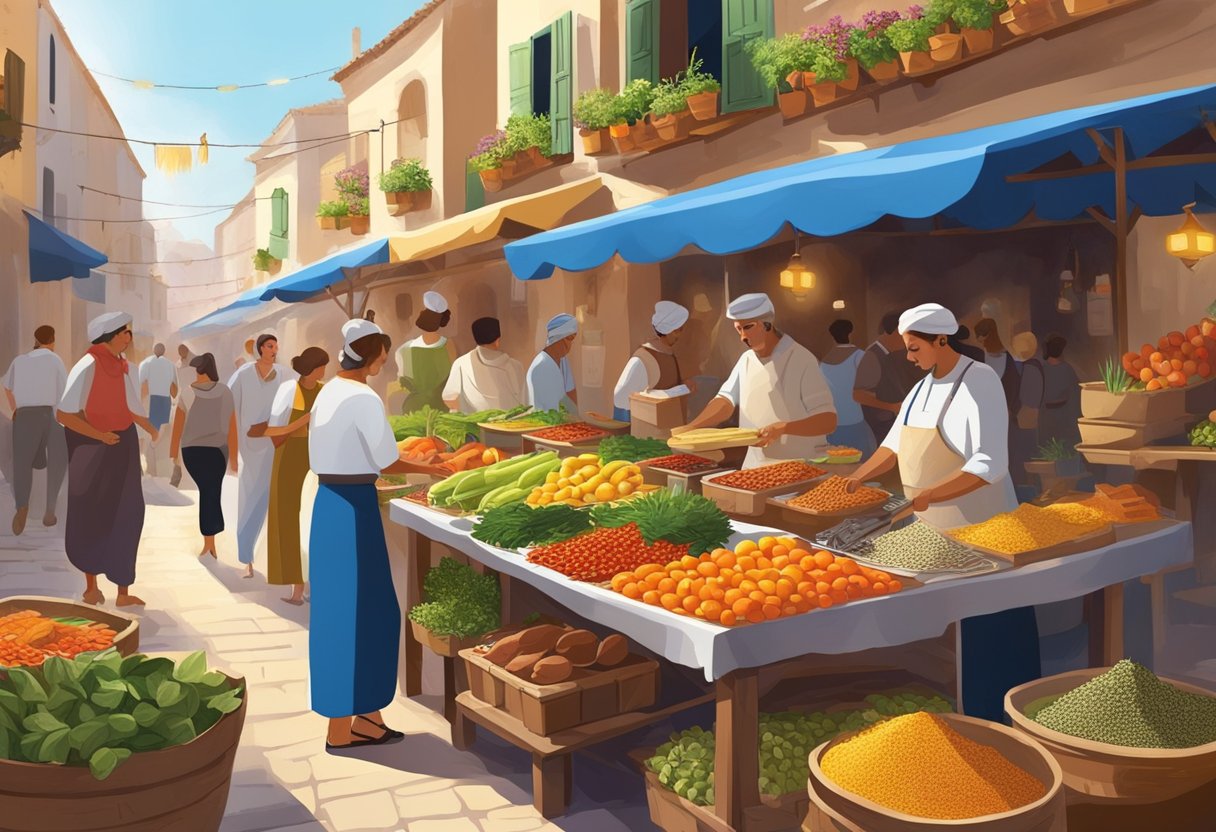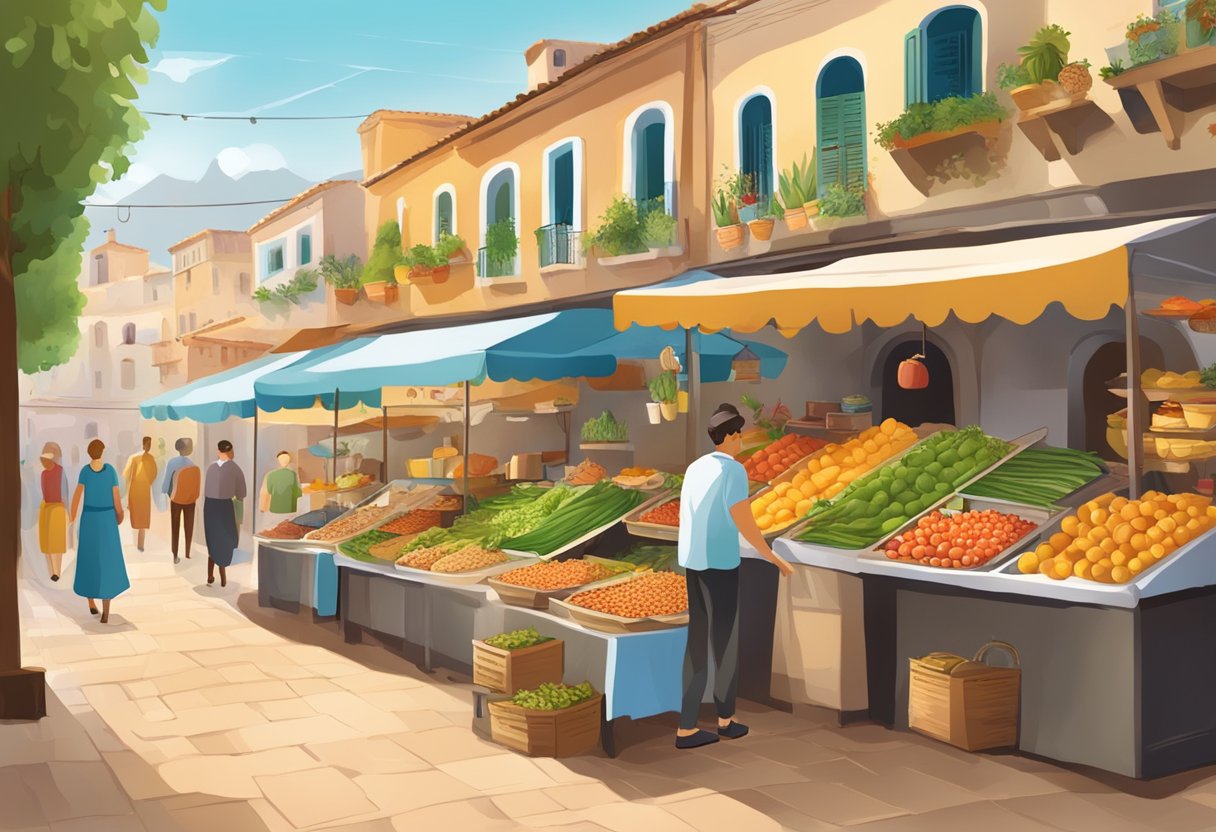Mediterranean street food offers a vibrant tapestry of flavors and textures, embodied in dishes that are both hearty and healthful. The emphasis on fresh, whole ingredients like fruits, vegetables, legumes, nuts, and lean proteins aligns well with a gluten-free lifestyle, making it an enticing option for those managing gluten sensitivities or celiac disease.
However, adapting traditional street food to a gluten-free Mediterranean diet requires careful attention to ingredients and preparation methods to maintain both the integrity of the flavors and the dietary restrictions.

The gluten-free Mediterranean diet merges the heart-healthy principles of its traditional counterpart with gluten-free necessities, providing a nutritious way of eating that can reduce the risk of chronic diseases. By focusing on inherently gluten-free foods such as rice, quinoa, and potatoes, as well as using alternative flours for baking and cooking, individuals can enjoy a variety of Mediterranean street food without gluten.
Whether it’s through recipes that recreate classic dishes or crafting new flavors within the dietary framework, there’s an abundance of options for a delicious and satisfying meal experience.
Key Takeaways
- Mediterranean street food aligns with a gluten-free diet through its use of fresh and whole ingredients.
- The gluten-free Mediterranean diet incorporates naturally gluten-free foods and alternative flours.
- Adapting recipes enables enjoyment of the diet’s full flavors while adhering to gluten-free restrictions.
Table of Contents
Understanding the Gluten-Free Mediterranean Diet
The Mediterranean diet is renowned for its emphasis on healthy fats, abundant vegetables, fruits, legumes, and whole grains. As its principles align with anti-inflammatory properties, it brings notable health benefits, potentially reducing the risks of heart disease, cancer, and type 2 diabetes.
A gluten-free Mediterranean diet adapts these principles for individuals with celiac disease or gluten sensitivity. Gluten—a protein found in wheat, barley, and rye—must be avoided in this variation of the diet.
To align with a gluten-free diet, traditional grain sources such as wheat breads and pastas are substituted with gluten-free alternatives. Here’s a simplified list of gluten-free substitutions within the diet:
- Whole grains: Brown rice, quinoa, buckwheat, corn, millet
- Breads: Made with gluten-free flour like almond or coconut flour
- Pastas: Derived from legumes (such as lentils and chickpeas) or gluten-free grains
Moreover, a gluten-free Mediterranean diet includes a variety of naturally gluten-free foods:
- Proteins: Seafood, poultry, legumes
- Vegetables and Fruits: All types
- Fats: Olive oil, avocados, nuts, and seeds
- Dairy: Moderate amounts of cheese and yogurt
Individuals must be diligent in ensuring that their food choices are free of gluten contamination. For example, while oats are naturally gluten-free, they commonly undergo processing alongside gluten-containing grains and therefore must be certified gluten-free to ensure safety for those with celiac disease.
By integrating these gluten-free options, individuals can enjoy the rich flavors of the Mediterranean while maintaining a diet that’s safe and beneficial for their health.
Fundamentals of Mediterranean Cuisine

Mediterranean cuisine is renowned for its emphasis on fresh, wholesome ingredients and vibrant flavors, which can easily be adapted to fit a gluten-free lifestyle.
Key Ingredients
The core of Mediterranean cuisine revolves around:
- Olive Oil: A staple for cooking and dressings, often with a preference for extra virgin olive oil.
- Fruits and Vegetables: Typically consumed in high volumes daily.
- Nuts and Seeds: Almonds, pine nuts, and sesame seeds are common.
- Legumes: Chickpeas, lentils, and beans provide protein and fiber.
- Whole Grains: Gluten-free options include buckwheat, corn, rice, and quinoa.
- Cheese and Yogurt: Usually consumed in moderation for calcium and flavor.
- Protein: Fish and poultry are preferred over red meat; eggs are also common.
- Wine: Often enjoyed in moderation with meals.
Common Spices and Herbs
Flavor in Mediterranean cuisine is achieved through the use of various herbs and spices:
- Oregano: A quintessential herb for seasoning dishes.
- Rosemary: Used for its aromatic essence in cooking.
- Parsley: Often used fresh as a garnish or as part of a dish for a bright accent.
- Olives: Both green and black varieties are used to enhance the flavor profile of numerous dishes.
Typical Mediterranean Cooking Techniques
Mediterranean recipes often involve:
- Grilling: For imparting a smokey flavor to vegetables, fish, and poultry.
- Roasting: To concentrate the natural flavors of ingredients.
- Sautéing: Using olive oil to cook food at a medium to high heat.
- Baking: Typically for casseroles, breads (using gluten-free flours), and sweets.
The techniques emphasize preserving the nutritional integrity and enhancing the natural flavors of the ingredients.
Creating a Gluten-Free Mediterranean Meal Plan

Crafting a gluten-free Mediterranean meal plan involves integrating traditional flavors with gluten-free alternatives to ensure nutritious and delicious meals throughout the day. Here are some specific meal ideas for each part of the day.
Breakfast Ideas
- Frittata with Spinach and Feta: Whisk together eggs, spinach, feta cheese, and tomatoes for a protein-packed start to the day.
- Greek Yogurt with Honey and Nuts: Layer Greek yogurt with a drizzle of honey and a sprinkle of almonds or walnuts.
Lunch Delights
- Quinoa Tabbouleh: Mix cooked quinoa with parsley, mint, diced tomatoes, and cucumber, finished with lemon juice and olive oil.
- Grilled Chicken Souvlaki Salad: Serve seasoned grilled chicken over a bed of greens with cucumber, tomatoes, and a dollop of gluten-free tzatziki sauce.
Dinner Options
- Baked Cod with Olives and Lemon: Bake cod fillets with lemon slices, olives, and herbs for a simple yet flavorful dish.
- Lamb Kofta Kebabs: Skewer ground lamb with gluten-free spices and grill, serving alongside roasted vegetables.
Snack Selections
- Stuffed Dates: Pit and stuff dates with a mixture of cream cheese and chopped pistachios.
- Hummus with Veggie Sticks: Enjoy homemade hummus with fresh carrot, bell pepper, and cucumber sticks.
Gluten-Free Alternatives in Mediterranean Cooking

Adopting a gluten-free Mediterranean diet involves replacing traditional gluten-containing ingredients with safe alternatives. The focus is on naturally gluten-free grains and flours, as well as finding creative swaps for commonly encountered gluten sources in Mediterranean dishes.
Safe Grains and Flours
Grains: Those following a gluten-free Mediterranean diet can safely enjoy a variety of grains. Key options include:
- Rice: Both white and brown rice serve as versatile gluten-free staples.
- Quinoa: A nutrient-rich seed that cooks like a grain and is a complete protein.
- Buckwheat: Despite its name, buckwheat is gluten-free and can be used in noodles and porridge.
- Corn: Ground into flour or polenta, corn is a common gluten-free choice for Mediterranean cooking. It can be used in baking or as a side dish.
Flours: A range of gluten-free flours are available for Mediterranean culinary creations:
- Almond Flour: Made from ground almonds; offers a nutty flavor and is rich in nutrients.
- Coconut Flour: A good source of fiber; often used in baked goods.
- Chickpea Flour: Also known as besan or gram flour; frequently used in Mediterranean flatbreads and fritters.
Substituting Common Gluten Sources
Many classic Mediterranean ingredients like couscous and traditional pita bread contain gluten, but suitable alternatives exist.
- Pasta Substitutes: Legume-based or corn pasta can replace regular pasta.
- Couscous Alternative: Cauliflower rice or quinoa can mimic couscous’s texture.
- Bread Swaps: Gluten-free pita bread made with a blend of safe flours allows diners to still enjoy dipping and wrapping foods.
- Binding Agents: Instead of wheat flour, xanthan gum or ground flaxseeds can be used to bind ingredients together in recipes such as meatballs or veggie burgers.
These gluten-free alternatives enable individuals to maintain a Mediterranean diet without gluten while still enjoying its rich flavors and health benefits.
Recipes for Key Gluten-Free Mediterranean Dishes
The Mediterranean diet is celebrated for its health benefits and delicious flavors. When adapted to be gluten-free, key dishes from this cuisine maintain their essence through the use of fresh, naturally gluten-free ingredients like vegetables, legumes, and proteins.
Appetizers and Salads
Mediterranean appetizers and salads introduce a variety of flavors and textures, often featuring quinoa, a gluten-free grain, which can be paired with chickpeas and cucumbers for a refreshing tabbouleh. For a salad with a twist, mix kale, red onion, feta cheese, and kalamata olives and dress with fresh lemon juice for a zesty side dish.
Quinoa Tabbouleh:
- Quinoa
- Fresh tomatoes
- Cucumbers
- Parsley
- Lemon juice
Greek Kale Salad:
- Kale
- Red onions
- Feta cheese
- Kalamata olives
- Lemon vinaigrette
Hearty Main Courses
Main courses in a gluten-free Mediterranean diet often involve grilling or marinating to enhance flavor. Legumes like lentils are staple ingredients in heartwarming stews. For protein, marinate salmon or seafood with aromatic spices and herbs complemented by sides of sweet potatoes or zucchini.
Lentil Stew:
- Lentils
- Garlic
- Tomatoes
- Spinach
- Spices
Grilled Salmon:
- Salmon fillets
- Olive oil
- Garlic
- Herbs
- Lemon juice
Desserts and Sweets
To satisfy the sweet tooth without compromising on the diet, use almonds, honey, and dates for naturally sweet treats. For a refreshing dessert, combine avocado with lemon juice for a creamy mousse that’s rich in flavor yet gluten-free.
Almond Date Bars:
- Almonds
- Dates
- Vanilla extract
- Sea salt
Avocado Lemon Mousse:
- Ripe avocado
- Lemon juice
- Honey
- Vanilla extract
Each dish reflects the nourishing essence of the Mediterranean while being mindful of gluten sensitivities, providing satisfying flavors for any meal.
Adapting Traditional Mediterranean Dishes

Traditional Mediterranean dishes are admired for their vibrant flavors and fresh ingredients. However, incorporating a gluten-free approach requires thoughtful substitutions and creativity, especially when it comes to staples like pasta, pizza, and street food favorites.
Gluten-Free Pasta and Pizza Variations
Gluten-free alternatives for pasta can be made from a variety of grains such as quinoa, rice, or corn. Spaghetti, for instance, can be replaced with gluten-free options that retain the classic texture but without the gluten. For pizza, crusts crafted from cauliflower or almond flour provide a delicious base and are fully compliant with a gluten-free Mediterranean diet.
- Spaghetti: Substitute with gluten-free quinoa pasta.
- Pizza Crust: Use almond flour or cauliflower as a base.
Mediterranean Street Food Favorites
The essence of Mediterranean street food is captured through its rich variety of flavors and ingredients, with many dishes already being naturally gluten-free. Items like grilled meats, seafood, and an array of salads are safe choices. However, certain street foods require adaptation — opt for gluten-free crackers instead of the traditional pita, or enjoy gluten-free grain options like buckwheat instead of couscous, farro, rye, or barley.
- Grilled Meats and Seafood: Already gluten-free, enjoy as is.
- Couscous Alternatives: Choose buckwheat or gluten-free rice options.
Nutritional Advice and Considerations

When transitioning to a Mediterranean Street Food diet that is also gluten-free, individuals should focus on consulting with professionals and understanding the ingredients in their foods. Accurate information and careful planning are vital to maintain a balanced diet, avoid gluten, and enjoy the culinary delights of the Mediterranean.
Consulting a Nutritionist
A nutritionist can provide tailored medical advice and assist in creating a personalized eating plan that aligns with an individual’s health needs and dietary restrictions. They are especially helpful when managing a gluten-free diet, as they can offer guidance on nutrient-dense, plant-based foods and suggest necessary supplements to prevent nutritional deficiencies. Ensuring this medical partnership helps one avoid the risks of self-diagnosis and establish a solid grocery list that is both nutritious and gluten-free.
Understanding Food Labels
Reading and comprehending food labels is crucial for those on a gluten-free Mediterranean diet. Items marked as “gluten-free” may still contain traces of gluten due to cross-contamination, or they could be highly processed. It’s important to look for labels that indicate whole food ingredients and to understand the terms related to gluten content. Becoming skilled in label analysis supports the inclusion of a variety of plant-based foods and aids in steering clear of unwanted gluten in one’s diet.
Mediterranean Diet and Lifestyle

The Mediterranean diet, celebrated for its numerous health benefits, emphasizes the consumption of olive oil, fruits, vegetables, and lean proteins. When adapted to a gluten-free lifestyle, it still retains its essence by substituting gluten-containing grains with alternatives like quinoa or brown rice.
Incorporating Physical Activity
The Mediterranean lifestyle is not just about food; it also involves regular physical activity. The inhabitants of the Mediterranean region frequently engage in walking, gardening, swimming, or cycling. Physical activity is seamlessly integrated into daily life, making it a natural part of one’s routine rather than a scheduled task.
Stress Reduction and Mindful Eating
Another pillar of the Mediterranean lifestyle is the focus on stress reduction and mindful eating. Meals are often enjoyed in a social setting, encouraging a relaxed atmosphere. The act of consuming food mindfully is practiced, with attention to the flavors and textures of the food, as well as an awareness of satiety cues. Olive oil plays a central role, not only as a healthy fat but also as a medium to enhance the taste of various dishes, promoting enjoyment in every bite.
Shopping and Meal Prep Strategies

When embracing a gluten-free Mediterranean diet, thoughtful planning is paramount. Individuals should begin by crafting a comprehensive grocery list that focuses on naturally gluten-free and Mediterranean-friendly items.
Fresh Produce:
- Fruits: Apples, berries, oranges, pears
- Vegetables: Leafy greens, bell peppers, zucchinis, tomatoes
Protein Sources:
- Plant-based: Lentils, chickpeas, beans
- Seafood: Salmon, trout, sardines
- Poultry: Chicken, turkey (ensure no gluten-containing additives)
Healthy Fats:
- Extra virgin olive oil
- Nuts and seeds (unprocessed)
- Avocados
Dairy:
- Greek yogurt
- Feta cheese
For meal preparation, they should prioritize simplicity and freshness. Batch cooking grains like quinoa or brown rice can serve as a versatile base for many meals. It’s helpful to prepare proteins ahead of time; grilling or baking fish and chicken allows easy integration into meals throughout the week.
When seasoning dishes, individuals must ensure all spices and condiments are gluten-free. They may make use of fresh herbs to bring out the natural flavors of the Mediterranean palette.
Additionally, many Mediterranean dishes can be naturally gluten-free without modifications, such as salads dressed in olive oil and lemon juice, or grilled seafood. Planning and preparing portions of ingredients, like chopped vegetables and marinated proteins, facilitate quick and efficient assembly of dishes.
For street food appeal, they can explore gluten-free wraps made with chickpea flour or corn tortillas to create gyros or falafels. This approach to street food ensures the enjoyment of diverse flavors while adhering to dietary needs.
Living Gluten-Free on a Mediterranean Diet
Adhering to a gluten-free Mediterranean diet can be a delicious and healthful way to manage celiac disease and support a gluten-free lifestyle. It requires mindfulness, especially when dining out or engaging in social activities where food is involved.
Dining Out and Social Gatherings
When individuals following a gluten-free Mediterranean diet choose to dine out or attend social gatherings, they should prioritize restaurants that offer gluten-free options or that are familiar with handling gluten-related dietary restrictions. Specific dishes that typically align with the diet include:
- Grilled fish or seafood: Ensure there are no bread crumbs or flour in the seasoning.
- Salads: Opt for those without croutons and with gluten-free dressings.
- Vegetable dishes: Check for the use of sauces or broths containing gluten.
They may also contact the restaurant ahead of time to verify preparations and avoid cross-contamination. Similarly, when attending social events, offering to bring a dish ensures there is a gluten-free option that still adheres to the traditional flavors of the Mediterranean region.
Educating Friends and Family
Individuals can help friends and family understand their dietary needs by sharing resources and recipes that elucidate what a gluten-free Mediterranean diet entails. It is beneficial to highlight the diet’s focus on:
- Legumes: such as beans, lentils, and chickpeas.
- Nuts and seeds: including almonds, walnuts, and flaxseeds.
- Fruits and vegetables: a wide variety prioritizing freshness and variety.
- Lean proteins: particularly from fish and poultry.
Informing friends and family can foster supportive environments at home and during gatherings, making the maintenance of a gluten-free Mediterranean lifestyle more achievable and sustainable.
Frequently Asked Questions
The transition to a gluten-free Mediterranean diet can be seamless with the proper knowledge of adaptable street foods, recipe resources, and ingredients necessary to maintain this lifestyle. These FAQs aim to provide clarity and guidance for those seeking to enjoy Mediterranean street food without gluten.
What are some staple Mediterranean street foods that can be easily adapted to a gluten-free diet?
Many Mediterranean street foods use inherently gluten-free ingredients like grilled meats, vegetables, and legumes. Foods such as kebabs, grilled corn, and stuffed grape leaves are naturally gluten-free and are staples in the Mediterranean street food scene.
Which cookbooks offer the best selection of gluten-free Mediterranean diet recipes?
Cookbooks specifically tailored for gluten-free eating, such as those found at Celiac.org, often feature a selection of Mediterranean diet recipes. They provide an array of options for those requiring a gluten-free diet and looking to enjoy Mediterranean cuisine.
How can one modify traditional Mediterranean street food recipes to fit a gluten-free dietary requirement?
To make traditional Mediterranean street foods gluten-free, one can substitute wheat flour with gluten-free alternatives like almond or chickpea flour, especially in recipes for flatbreads and pastries. Gluten-containing sauces and dressings can be replaced with olive oil, lemon juice, and herbs.
Can you provide a sample gluten-free Mediterranean diet meal plan that includes street food options?
A sample gluten-free Mediterranean diet meal plan could include hummus and vegetable sticks, grilled chicken gyro with gluten-free pita, and roasted chickpeas. These dishes maintain the diet’s focus on fresh and healthy fats, while offering the convenience of street food.
What should be included in a gluten-free Mediterranean diet shopping list to prepare street food dishes at home?
A shopping list for preparing gluten-free Mediterranean street food at home should include fresh vegetables, fruits, legumes, nuts, seeds, seafood, poultry, dairy, and gluten-free grains like rice and quinoa. Spices and herbs are also essential for authentic flavor.
Are there any quick and easy gluten-free breakfast options that align with the Mediterranean diet principles?
For a quick and easy gluten-free breakfast that aligns with Mediterranean diet principles, choices include Greek yogurt with nuts and fruit, shakshuka with gluten-free toasted bread, and frittatas packed with vegetables and healthy fats. These options are both nourishing and fulfilling.



